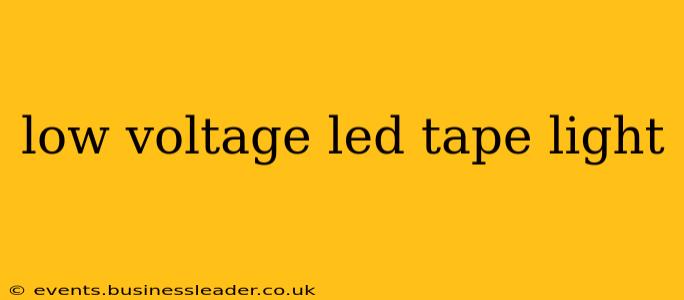Low voltage LED tape lights have revolutionized interior and exterior lighting, offering a versatile and energy-efficient solution for a wide range of applications. Their sleek design, customizable lengths, and ease of installation make them a popular choice for homeowners and businesses alike. This comprehensive guide will explore everything you need to know about low voltage LED tape lights, from their benefits and applications to installation and troubleshooting.
What are Low Voltage LED Tape Lights?
Low voltage LED tape lights, typically operating at 12V or 24V, consist of flexible circuits populated with small, surface-mount LEDs. This design allows for easy installation in various locations, including under cabinets, behind furniture, inside alcoves, and even outdoors (with appropriate weatherproofing). Unlike high-voltage alternatives, these lights require a power supply to step down the voltage from your standard 120V (or 230V) mains electricity. This lower voltage significantly improves safety and reduces the risk of electrical shock.
Benefits of Using Low Voltage LED Tape Lights
- Energy Efficiency: Low voltage LEDs consume significantly less energy than traditional incandescent or even many halogen alternatives, leading to lower electricity bills and a smaller carbon footprint.
- Flexibility and Versatility: The flexible nature of the tape allows for installation in virtually any shape or curve, making them ideal for highlighting architectural features or creating ambient lighting. They can be cut to length, allowing for precise customization.
- Long Lifespan: LEDs boast a significantly longer lifespan than incandescent bulbs, reducing replacement costs and maintenance.
- Easy Installation: Low voltage LED tape lights are generally easy to install, even for DIY enthusiasts. However, proper wiring and safety precautions are crucial.
- Color Options: Available in a wide range of colors, from warm white to cool white and even RGB options for dynamic color changing capabilities.
- Dimmable Options: Many low voltage LED tape lights are dimmable, providing greater control over the ambiance and brightness.
What are the Different Types of Low Voltage LED Tape Lights?
There's a range of choices available when it comes to low voltage LED tape lights, each with its own characteristics:
- Single Color LED Tape: These offer a consistent color temperature (e.g., warm white, cool white) throughout the strip.
- RGB LED Tape: These strips contain red, green, and blue LEDs, allowing you to mix colors to create a wide spectrum of hues. Often controlled via a remote or smartphone app.
- RGBW LED Tape: Similar to RGB, but with the addition of white LEDs for more accurate white light and improved color mixing.
- Waterproof LED Tape: Designed for outdoor use, these tapes are sealed against moisture and dust, typically with an IP65 or higher rating.
How Much Power Does Low Voltage LED Tape Light Use?
Power consumption varies depending on the length and density of LEDs on the tape. The specifications (usually in watts per meter) are clearly stated by the manufacturer. You'll need to calculate the total wattage of your setup to ensure you select an appropriately sized power supply.
How to Install Low Voltage LED Tape Lights
Installing low voltage LED tape lights generally involves these steps:
- Planning and Measurement: Carefully measure the area where you plan to install the lights and determine the required length of the tape.
- Surface Preparation: Ensure the surface is clean and dry.
- Attaching the Tape: Use the adhesive backing or appropriate clips to securely attach the tape to the surface.
- Connecting the Power Supply: Connect the tape to the power supply, ensuring correct polarity. Improper connection can damage the lights.
- Testing and Adjustment: Test the lights to ensure they are functioning correctly and make adjustments as needed.
Always consult the manufacturer's instructions for specific installation guidance.
What is the Lifespan of Low Voltage LED Tape Lights?
The lifespan of low voltage LED tape lights is typically quite long, often exceeding 50,000 hours. However, this can vary based on usage, environmental conditions, and the quality of the LEDs.
How to Choose the Right Low Voltage LED Tape Light
Consider these factors when selecting low voltage LED tape lights:
- Brightness (Lumens): Choose a brightness level appropriate for your application.
- Color Temperature (Kelvin): Select a color temperature that complements your décor.
- Wattage: This determines energy consumption.
- Waterproof Rating (IP Rating): Essential for outdoor applications.
- Length: Choose the appropriate length for your needs, remembering you can cut most tapes to size.
- Type of LED (Single Color, RGB, RGBW): Depends on your desired functionality and color options.
This guide provides a solid foundation for understanding and utilizing low voltage LED tape lights. Remember that safety should always be your top priority, and consulting a qualified electrician is always recommended for complex installations or outdoor applications.
